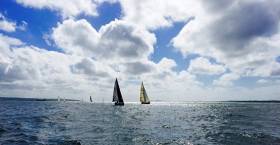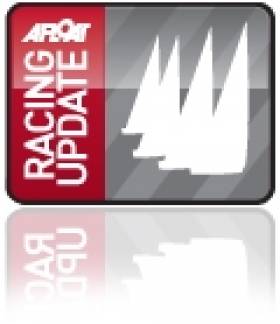Displaying items by tag: West of Ireland Offshore Racing Association
After four races sailed in WIORA at Kilrush Marina, John Collins Ibaraki from Galway Bay Sailing Club contiunes his lead in the week's biggest class on the Shannon Estuary in County Clare. The modified GK34 leads Ray McGibney's Dehler 34 Disaray from Foynes Yacht Club after three races sailed in the 10–boat fleet class two fleet.
In class one at the Royal Western Yacht Club of Ireland event, Yannick Lemonnier's Galway Flyer, an SJ320, from Galway Bay Sailing Club, has the narrowest lead of .25 points over the First 36.7, 2 IRL1514 Zallaq (Duncan & Emmet Kerin) from the host club in a five–boat fleet.
In a five boat class three made up entirely of J24s, Darragh McCormack's Maximus from Foynes Yacht Club leads Fenit's Jaguar sailed by Gary Fort of Tralee Bay Sailing Club.
30–boats are competing in three classes in the 40th anniversary of the event. Racing continues today.
Foynes YC to Host 2012 WIORA West Coast Championships
#WIORA– As a flagship event to mark their 50th year of sailing on the Shannon Estuary, Foynes Yacht Club are setting an aggressive target to attract 50 boats to next year’s West of Ireland Offshore Racing Association (WIORA) sailing championships to be held from the 11th to 14th of July. The WIORA poster is below.
Ed Conway and Raymond McGibney are flying the flag for Foynes having being recently re-elected to the WIORA committee for another year.
IRC, ECHO and White Sails classes will be raced and the club says a festival atmosphere ashore will be 'guaranteed with well-priced, quality catering and top class live entertainment' provided at the recently renovated clubhouse.
All boats entered will be given free and secure berthing. Free lift-in/lift-out of trailer sailors will also be arranged. Liam Dineen has been appointed OOD and already over forty boats have registered.
In addition to all Western clubs, Foynes will be canvassing sailors from the active racing fleet on Lough Derg to come by road or river to join in this celebration sailing event, last held in Foynes in 1998.
While standard “around the cans” windward-leeward courses will be laid for the IRC and Echo fleets, more varied courses for white sails will be set, taking yachts to all parts of the scenic estuary. A special section is currently being added to the club website to cover all aspects of the event.
More on The Estuary here

WIORA Grant €1000 to Royal Western Yacht Club
“It is very important for the West of Ireland Offshore Racing Association to be actively promoting and developing sailing along the west coast. By way of this grant the association has the opportunity of putting the money back into sailing at grass roots level” – Simon Mc Gibney Commodore West of Ireland Offshore Racing Association.

“On behalf of the Royal Western Yacht Club of Ireland, I would like to sincerely thank the members of the West of Ireland Offshore Racing Association for this very generous grant which will help in the development of sailing at the Royal Western Yacht Club of Ireland” – Adrian O’Connell Commodore Royal Western Yacht Club of Ireland.
WIORA Heads for Clifden Next July
West of Ireland Offshore Racing Association
The West of Ireland Offshore Racing Association (WIORA) is a membership-based association for promotion and development of cruiser racing and cruising on the West Coast of Ireland. For all the latest WIORA news click here.
The association provides and promotes an annual programme of events, Inshore, Offshore and Coastal for cruiser racing, working closely with the various clubs along the western seaboard.
We have an exciting programme of events for 2009 for you to look forward to which includes the Irish Cruiser Racing Association – National Cruiser Championships and the West Coast Championships being hosted by Tralee Bay Sailing Club in June and, if that wasn’t enough, the OneSails McWilliam West Coast Super League which has being growing in popularity and going from strength to strength.
Please feel free to contact a representative of the association for any further information, their contact details can be found here
Simon McGibney, Commodore
There is a space for Irish boating clubs and racing classes to use as their own bulletin board and forum for announcements and discussion. If you want to see a dedicated forum slot for your club or class, click here


























































